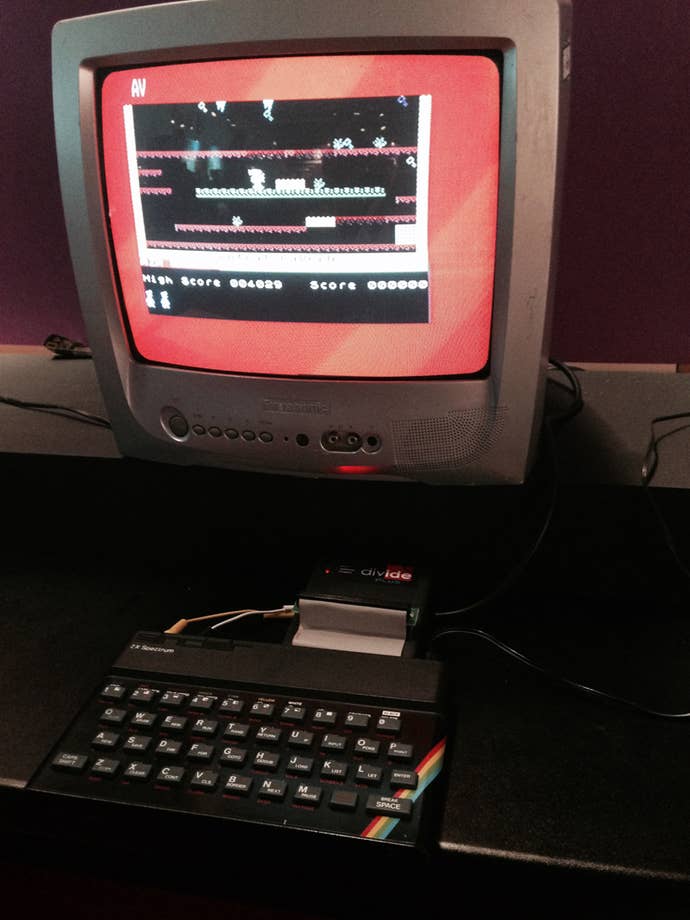We Meet at Last, ZX Spectrum (Bonus: A Manic Miner Mario Maker Level)
Also Amstrad's obscure attempt to challenge Nintendo and Sega, and other examples of European gaming history at EGX.
This article first appeared on USgamer, a partner publication of VG247. Some content, such as this article, has been migrated to VG247 for posterity after USgamer's closure - but it has not been edited or further vetted by the VG247 team.
In the early days of Retronauts, one of the most common requests we heard was for a show about British gaming history. Fans would ask, "When are you going to do a show about the ZX Spectrum and the Amiga," to which we would reply with a collective shrug because we were just a bunch of Americans.

Nevertheless, I've retained a degree of curiosity for British gaming history, mostly because it's rather foreign to me. Platforms like the ZX Spectrum seem to have had an impact on British gamers of a certain age comparable to that of the Commodore 64.
Thus, it was not surprising to find a ZX Spectrum in EGX's Replay Arcade along with a host of other devices including a Vetrex, Commodore 64, and an Atari ST.
Like most computers of its type, the ZX Spectrum is basically keyboard attached to a monitor. The keys are the tiniest bit squishy - certainly not as crisp and clacky as a mechanical keyboard - but otherwise it's a solid-looking piece of equipment. On the screen was Manic Miner - a 1983 platformer regarded by many as a classic in the UK. Using slow, arcing jumps, you try to collect all of the keys in a given level, then escape before the main character's oxygen runs out.
At the time, Manic Miner stood out for its bright colors, in-game music (a looping track of In the Hall of the Mountain King), and little touches like an animated loading screen. It feels a bit archaic by modern sensibilities - especially when you consider that the much more attractive and playable Super Mario Bros. was released just a couple years later - but it stlil makes for a fun challenge to maneuver around the bricks and platforms without touching the Zoidberg-like enemy or the (presumably poisonous) plants. I managed to make it all the way to the end of the level, but alas, a mistimed jump brought with it instant death and a return to the beginning of the level.
When I got back to the press room, I asked Eurogamer's Tom Phillips if he had a Spectrum or Amiga growing up. He replied, "It was a little before my time." His father had owned a Spectrum, though, which he had unfortunately sold for pennies on the dollar (I can relate, having stupidly sold my own NES once I had "outgrown" it). In that light, British gaming history seems to have followed a similar trajectory to that of the U.S., with microcomputers being gradually supplanted by home consoles and more generic desktop computers.
As it turns out, though, Eurogamer's video producer Ian Highton is a big Manic Miner fan, and even created a Mario Maker level based on it (at one point jokingly telling the froom, "If not for the ZX Spectrum, none of you would have jobs").
Amusingly, Ian's Mario Maker level in some ways does a better job of conveying the spirit of Manic Miner than the game itself, with Mario Maker's tight controls supplanting Manic Miner's slower, floatier jumps. Your goal is still to grab up coins, but instead of the exit opening up automatically, you have to hit a P Block and hustle out the door. If you're quick enough, you can sometimes make it to the second exit - a mild but charming design flaw that encourages speed and familiarity with the level. If you want to try it for yourself, you can check it out using this code: 47DG-0000-0062-BF04.

As for the Replay Arcade, the remaining games are mostly universal favorites - Mario Kart, Sonic, Goldeneye, and Smash Bros. among them. Rogue Leader for the Gamecube is there, and it continues to look impossibly good for a game released 14 years ago. By far the weirdest and most interesting console on display was the Amstrad GX4000 - a European console that racked up a mere 15,000 sales before Amstrad pulled the plug on production in 1991. It launched to decent reviews, and at £99 it was relatively inexpensive, but it was quickly overrun by Nintendo and Sega. Even by the standards of the day, it feels pretty underpowered, its pack-in racing game - Burnin' Rubber - looking only slightly better than NES games like Rad Racer. Still, it's an interesting curiousity, being obscure to the point that it doesn't even warrant a mention in Wikipedia's list of home consoles.
In some ways, walking around the exhibit makes me a bit sad. At the end of the day, the ZX Spectrum and its ilk weren't all that different from what was on offer in other countries, but Manic Miner and its ilk nevertheless had an undeniable impact on European gaming. I'm not exactly complaining about the huge variety of games available around the world now, but it does speak a bit to the homogenization of culture that has taken hold in the western world. When you find something even the least bit different, it becomes electric and interesting now - something to treasure.
For now, at least we have Ian's Mario Maker level.









